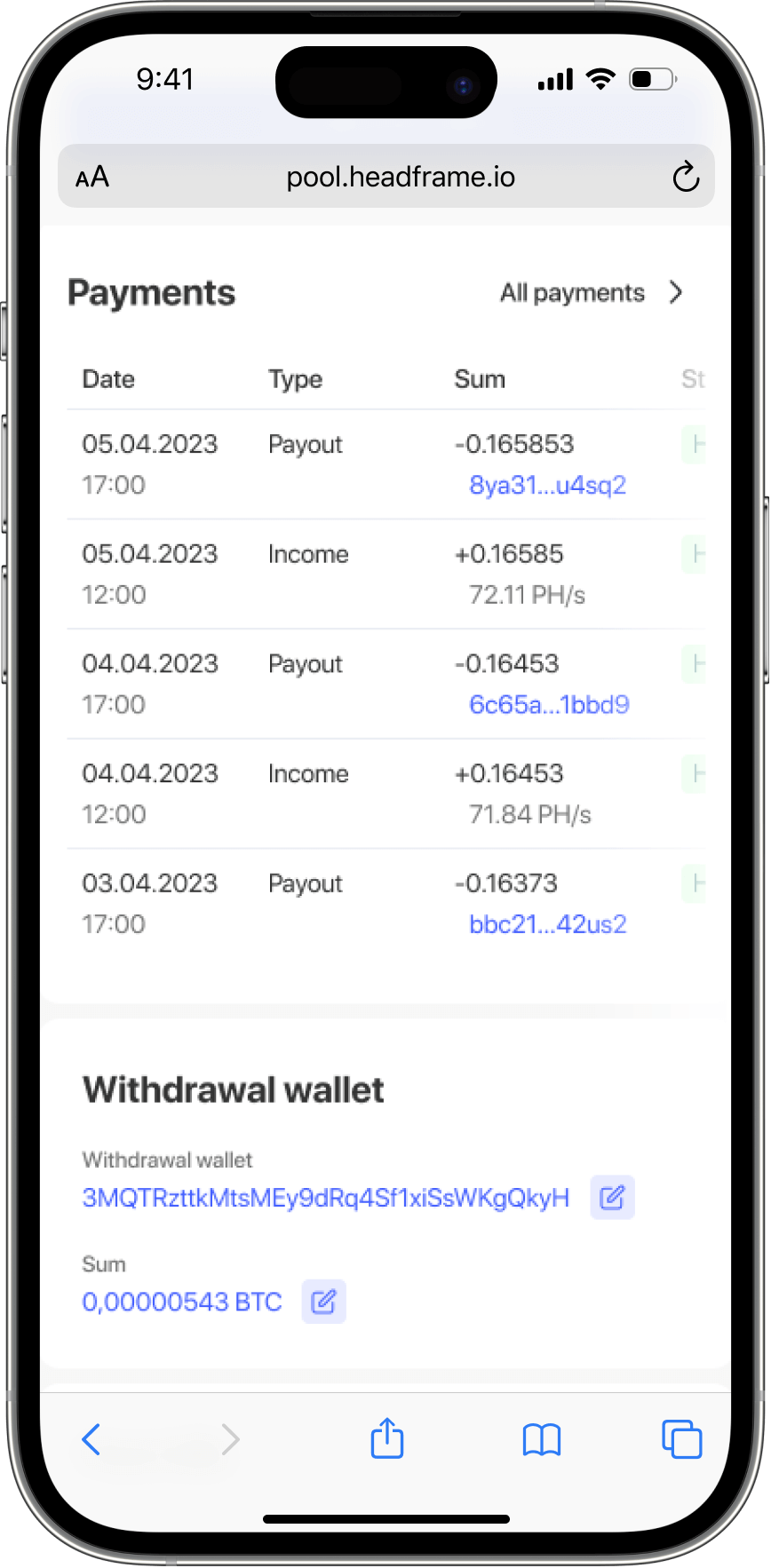
History of money: from fiat to cryptocurrency, explanation
The article talks about the history of money, from barter transactions to modern cryptocurrencies. It is explained how to determine the nature of cryptocurrency (inflationary or deflationary) and what is the next stage in the evolution of money. Monetary adjustment mechanisms and changes in the volume of inflationary and deflationary coins are described. Also discusses possible changes to the monetary system, including the move to digital currencies and regulatory measures to protect the public interest.
Earn more money with Headframe
Join a mining pool and get the best profitability in mining. Already more than 10,000 miners trust Headframe.
- What is money and why is it trusted?
- The evolution of money
- What is the gold standard?
- What distinguishes barter from the monetary system?
- What is the impact of monetary policy on inflation?
- How to determine the nature of cryptocurrency: inflationary or deflationary
- What is the next stage in the evolution of money?
What is money and why is it trusted?
Money plays a central role in human civilization and economic growth. It serves as a tool to store value and facilitate exchange, allowing individuals to exchange goods, services and other valuables.
Money has taken different forms in different historical periods, from coins to paper money and finally to digital assets such as cryptocurrencies. Modern money issued by central banks is used by various entities for a multitude of purposes.
Much of modern money is digital, which supports the idea of money as a social construct. Ultimately, money is based on a collective contract or “social fiction” created to enable trade. Trust is the basis for facilitating exchange, whether it is through direct exchange or through an accepted medium of exchange such as money.
Money is really based on trust and has no intrinsic value; its value is determined by social acceptance. This trust gives them strength, making them a valuable tool for exchange. An example of this approach is the currency system of the island of Yap with the “rai stones”, where the value of a stone depended on its origin and properties. Surprisingly, the stones were not passed from hand to hand; instead, rights to them were transferred orally, preserved in collective memory.
It can be argued that money is a creature of political systems. The state and central banks have the power to regulate and create money. As long as central banks decide how much money should be in circulation, public trust in these institutions facilitates the functioning of the monetary system. In addition to trust in government authority and the economy, the value of money is also determined by its necessity and demand. Despite the limited quantity of money, phenomena like inflation or deflation reflect the variability of its value.
Evolution of money
Money has evolved from basic barter commodities to today’s cryptocurrencies. They originally served as a tool to facilitate exchange between strangers. As societies evolved and became more complex, the need for a universal medium of exchange grew.
In the context of history, the concepts of value and possession have always been key. The first money was barter goods, such as minerals or livestock, valued for their utility and rarity.
After the agricultural revolution, with the expansion of human settlement and intensification of cultural interaction, the concepts of economics and trade that preceded the creation of money emerged. Ancient civilizations used commodity money, but it was the introduction of metal money that transformed the understanding of monetary systems.
Metal money was the catalyst for the creation of centralized political organisms and the founding of modern states. They provided leaders with the means to form bureaucracies and armies, increasing control over large tracts of land. Money stimulated trade, which in turn increased economic prosperity and strengthened the state structure by creating a uniform system of exchange rates and improving trade.
At the beginning of the banking era, goldsmiths held gold and other precious metals, issuing receipts that became instruments of payment. These receipts gradually turned into representative money, paving the way for the creation of modern paper money.
Half a century ago, money was exclusively physical. Nowadays, however, electronic or fiat money has become the main means of payment based on the electronic recording of transactions. This money relies on trust in government and central banks. In fact, governments regulate the money supply by changing it through various economic instruments like issuance or rates. Modern fiat money is usually not linked to physical reserves and has no intrinsic value.
With digital innovation, money has taken on new forms, from credit cards to cryptocurrencies. Technologies such as mobile payments and cryptocurrencies, especially since the emergence of bitcoin in 2008, have redefined our approach to money, emphasizing its constant evolution in society.
What is a gold standard?
Until 1971, many countries used the gold standard, whereby a country’s currency was pegged to gold. This meant that each banknote could be exchanged for a certain amount of gold. Some argue that the move away from this system led to economic fluctuations and a decline in the role of nations. Others see it as an inevitable development towards a more fluid world economy.
One of the major drawbacks of the gold standard was its restriction on monetary policy, preventing it from adapting to economic conditions. When the US abandoned the dollar’s peg to gold in 1971, it effectively transformed money into a form of debt. To illustrate, while an ounce of gold cost $35 in 1971, half a century later its price had jumped to $2,100, indicating a significant devaluation of the dollar.
This turn of events had many consequences for states, populations and society as a whole. The abandonment of the gold standard increased currency fluctuations and led to a lack of financial discipline among states, causing economic instability and inflationary risks. It also shifted economic leverage away from the state and toward the market, weakening state influence over economic policy.
The departure from the gold standard particularly affected the middle and lower classes. Inflation due to lack of financial discipline hit hardest those with less money, increasing economic inequality.
However, there is a view that the end of the gold standard was key to the creation of a more fluid world economy. In this view, government influence has not lost its importance, but has been transformed by new monetary policy methods. This change allowed for the construction of a more adaptive financial system, giving governments more tools to respond to economic challenges and stimulate growth.
In addition, it can be said that such a move has expanded opportunities for economic activity and wealth through increased credit and growing financial markets.
What distinguishes barter from the monetary system?
Barter is a method in which goods and services are exchanged directly for other goods and services without the intermediate use of money. The main disadvantage of barter is the lack of a unified measure of value and the problems of finding an appropriate exchange. In a monetary system, in turn, currency acts as an intermediary for exchange and a standard of value, which simplifies the transaction process.
Barter was the original (decentralized) form of exchange, while the monetary system is a centralized method, using money as the exchange agent. Both systems were based on social trust and recognition by market participants.
Under barter, goods and services were exchanged directly, without money or a centralized agent. People exchanged what they had in abundance for what they needed or wanted. This method was typical of ancient societies before the advent of currency.
Today’s monetary system provides a universal measure of value, simplifying trade. Barter lacked such a standard, causing problems with complex exchanges. While barter was a natural product of human society, the modern monetary system is also linked to centralized political structures. Thus, government agencies decided to abandon the gold standard in favor of modern monetary policy methods.
The monetary system, with its centralized features, faces a number of vulnerabilities. In particular, it relies on a centralized account, subject to control and limiting the anonymity of transactions (unless cash is involved).
The emerging cryptocurrency represents a new stage in the development of money, having superiority over barter and traditional money. Barter transactions depended on the mutual need of the parties. The traditional monetary system, on the other hand, is based on trust in the value of the monetary unit, despite the threat of inflation and loss of trust in the government institutions and banks that control the system.
In contrast, cryptocurrencies provide the opportunity for fast, decentralized transactions without the need for trust, while having improved security and privacy.
What is the impact of monetary policy on inflation?
Monetary policy is determined by the actions of the central bank in terms of money supply and interest rates in order to fulfill economic objectives. The setting of low rates by the central bank can increase the availability of money for borrowing, which in turn can cause inflationary trends in wages and consumer prices or vice versa. Central banks have now developed new methods of monetary adjustment, including wholesale and retail refinancing.
How to determine the nature of cryptocurrency: inflationary or deflationary
Cryptocurrencies are a relatively new monetary instrument and their nature can be either inflationary or deflationary, depending on the monetary policy and architecture adopted. To categorize cryptocurrency, it is advisable to look closely at its volume changes, demand drivers, usage patterns and ability to retain its value.
The underlying mechanisms and changes in the volume of inflationary and deflationary coins directly affect their practicality and value. If the volume of a cryptocurrency is limited in advance, it is generally considered deflationary: its value will increase over time as demand increases.
Deflationary coins help to conserve funds and reduce consumer spending, which ultimately leads to increased demand for them as a value preservation tool. Thus, their purchasing power increases over time. Moreover, the decreasing volume of such coins provides protection against inflationary risks caused by external circumstances, such as government policies or economic shocks.
In contrast, if the volume of a cryptocurrency changes, its nature can be either inflationary or deflationary, depending on the rate at which new coins are issued and other aspects. Inflationary coins encourage spending and reduce the tendency to hoard. These characteristics make such coins attractive as a medium of exchange, enhancing their liquidity.
Notably, inflationary tokens are flexible, allowing their inflation rates to be adjusted depending on the interests of the company, be it the issuance of new tokens or other aspects factored into the company’s economic model.
It is also worth emphasizing that defining a cryptocurrency as inflationary or deflationary may depend on different interpretations. In the case of BTC, for example, its perception as an inflationary or deflationary currency depends on multiple aspects. The increasing supply of BTC is due to the constant mining of new coins, but measures such as halving reduce this inflationary impact over time. The situation is similar with altcoins like Ether (ETH).
What is the next stage in the evolution of money?
We are in a period where new technologies are changing the traditional view of money. With the emergence of cryptocurrencies and crypto-wallets, monetary systems are transforming, becoming more decentralized, electronic and accessible. However, states are also actively involved in shaping the future of finance, which may mean attempts to increase centralized control and establish strict rules in the handling of money.
The history of money has many stages, from barter transactions to modern electronic currencies. Most modern currencies are not linked to a specific tangible asset. They are based on the government’s ability to manage its economy and regulate inflation through fiat money. The value of fiat money today is based on trust in the authorities issuing it.
Since the abandonment of the gold standard, it has become apparent that the value and stability of fiat money can be subject to inflationary risks and other problems like unregulated monetary policy, mismanagement, and deteriorating institutions. Government agencies and central banks are likely to participate actively in the monetary system.
Monetary systems will continue to transform, becoming digitalized with the emergence of new payment methods such as cryptocurrencies. The use of cash is likely to decrease as many nations move towards cashless transactions, with or without the involvement of central banks. The shift to digital currencies will affect privacy, security and economic equality.
New regulatory measures may be introduced to protect the interests of the public or even replace the existing monetary system. It remains an open question whether the combination of cryptocurrencies, Web3 and DeFi will lead to the separation of finance from government control. Perhaps it will create a truly decentralized and open economic system.
Source: https://cointelegraph.com/explained/history-of-money-from-fiat-to-crypto-explained


